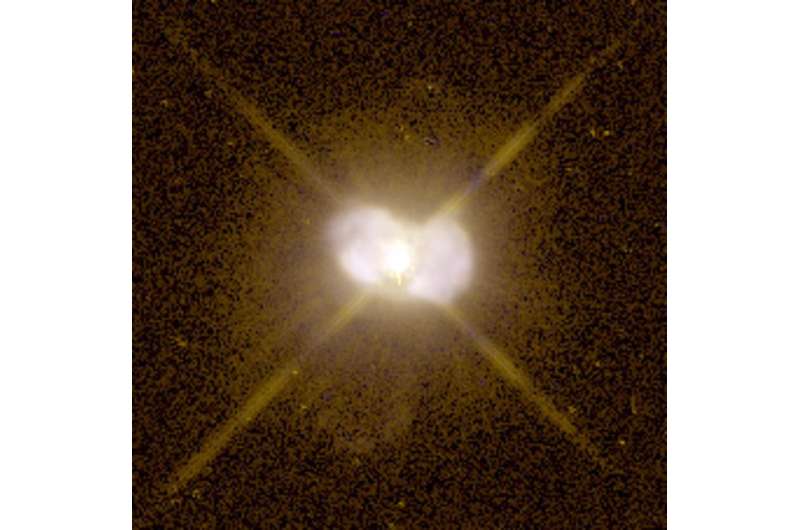May 23, 2022 report
Research sheds more light on the properties of young planetary nebula IC 4997

Using the Five-hundred-meter Aperture Spherical radio Telescope (FAST), astronomers have observed a young planetary nebula known as IC 4997. Results of the observational campaign, presented in a paper published May 12 on arXiv.org, deliver important insights into the properties of this object.
Planetary nebulae (PNe) are expanding shells of gas and dust that have been ejected from a star during the process of its evolution from a main sequence star into a red giant or white dwarf. They are relatively rare, but are important for astronomers studying the chemical evolution of stars and galaxies.
Located some 8,000 light years away from the Earth, IC 4997 is a young, compact, and rapidly evolving PN in the constellation Sagitta. Its temperature is about 20,000 K and it has a relatively high surface brightness. It contains a prominent central star with a temperature of around 49,000 K.
A team of astronomers led by Xu-Jia Ouyang of Sun Yat-sen University in Zhuhai, China, has recently performed radio observations of IC 4997 using the tracking mode of the FAST 19-beam receiver. The telescope allowed them to detect neutral atomic hydrogen absorption in this PN, which may have implications for our understanding of its nature.
"Circumstellar H I absorption is clearly detected in the radio spectrum of IC 4997, the first such detection from FAST. This feature originates from a shell associated with one of the velocity components of the Na I D lines," the researchers wrote in the paper.
The discovery is important given that the number of PNe with circumstellar neutral atomic hydrogen detections is extremely small, compared to the total number of verified Galactic PNe (about 3,800). Finding and investigating such features could improve our knowledge on the mass and dynamics of the atomic gas budget in PNe.
The high-resolution and high-sensitivity FAST spectrum allowed the researchers to precisely estimate the parameters of the circumstellar H I absorption. The local standard of rest (LSR) velocity of the peak absorption was measured to be −63.27 km/s, and the full width at half maximum (FWHM) was found to be 12.74 km/s. When it comes to the maximum absorption flux density, it was calculated to be −8.07 mJy, while the integrated flux density turned out to be at a level of −136.7 mJy km/s.
The study found that the total number of hydrogen atoms in the atomic shell of IC 4997 is about 17 septendecillion. This hydrogen atomic shell has a mass of some 0.0146 solar masses and the results suggest that it was ejected at least 990 years ago during the superwind phase. The column density of the neutral atomic hydrogen was estimated to be approximately 710 quintillion cm−2.
The astronomers noted that the neutral hydrogen in IC 4997 is comparable to the ionized nebula in mass, and may have increased over the past 36 years. However, the total nebular mass is still far less than that expected for the superwind. They added that their detection demonstrates the feasibility of using FAST to search for atomic hydrogen in a large sample of PNe and to reveal new insights into the so-called PN missing mass problem.
More information: Xu-Jia Ouyang et al, FAST search for circumstellar atomic hydrogen–I: the young planetary nebula IC 4997. arXiv:2205.06170v1 [astro-ph.SR], arxiv.org/abs/2205.06170
© 2022 Science X Network





















